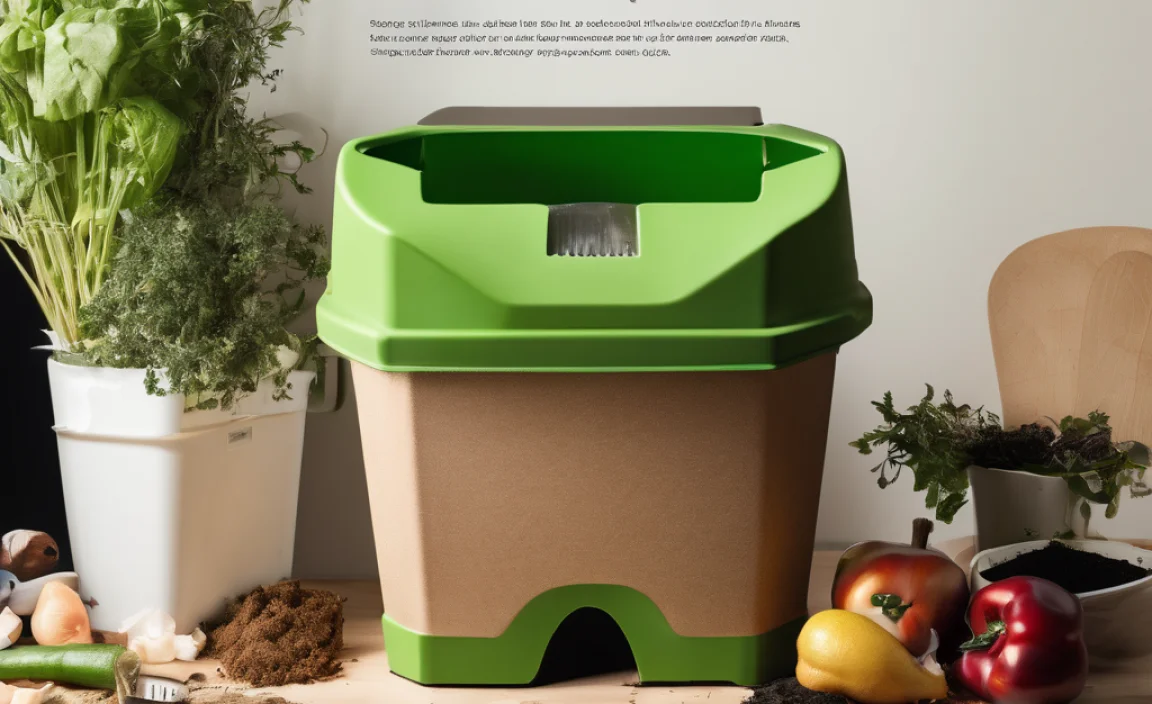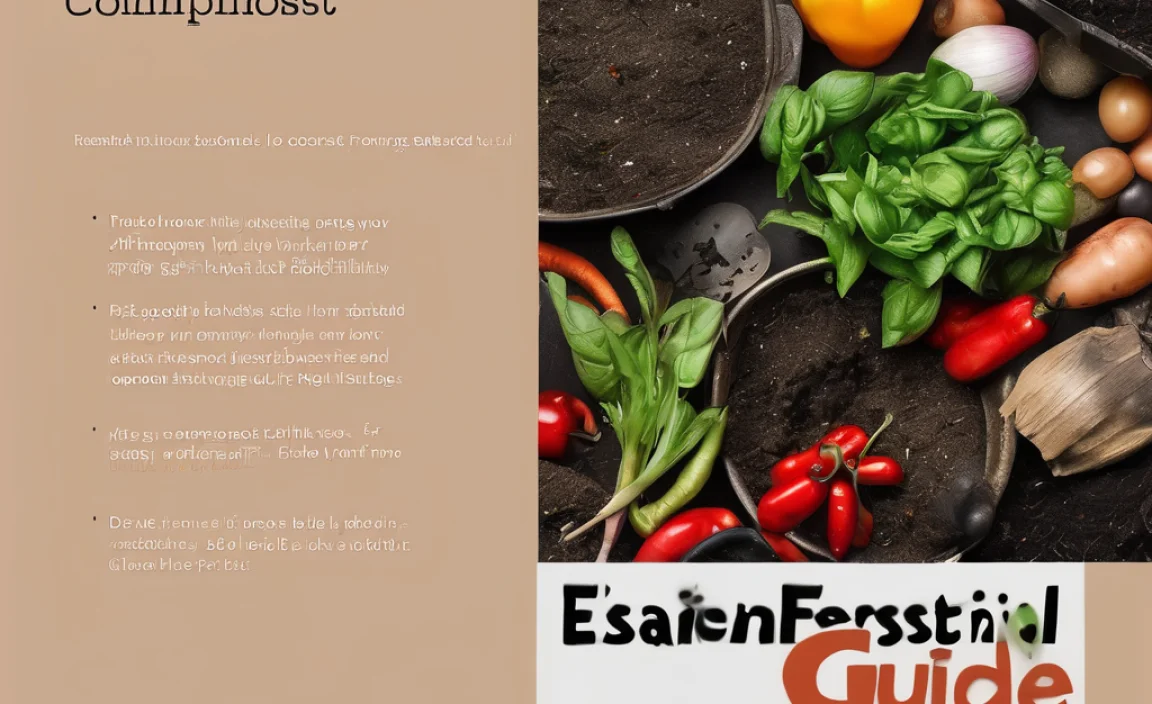Got banana peels hanging around? Don’t toss them! These golden beauties are packed with nutrients your garden will absolutely love. Many folks think composting is complicated, or that certain things, like banana peels, can’t be composted. But guess what? It’s actually super simple, and those peels are a composting rockstar.
This guide will walk you through everything you need to know, step-by-step. We’ll cover why they’re great for your compost, different ways to add them, and what to avoid. Get ready to turn your kitchen scraps into garden gold!
Why Banana Peels are Awesome for Your Compost Bin
Banana peels aren’t just for slipping on in cartoons; they’re a treasure trove of goodies for your compost. They’re like nature’s little fertilizer packets, just waiting to be unlocked.
- Rich in Potassium: This is key for healthy plant growth, especially for flowers and fruits. Think of it as the “flowering and fruiting” nutrient.
- Packed with Calcium: Good for strong cell walls in plants and preventing blossom end rot in things like tomatoes and peppers.
- Contain Magnesium: Essential for photosynthesis, which is how plants make food. More magnesium means greener, healthier leaves.
- Add Nitrogen: While not as high in nitrogen as some other kitchen scraps (like coffee grounds or vegetable trimmings), they still contribute, helping to balance out the “browns” in your compost.
- Break Down Quickly: Compared to woody materials, banana peels break down relatively fast, meaning your compost pile gets a nutrient boost sooner.
Are Banana Peels Really Compostable? Yes, and Here’s Why You Should!
Absolutely! Banana peels are a fantastic addition to your compost pile. Many beginners worry about things attracting pests or smelling bad, but when composted correctly, banana peels (and other kitchen scraps) become a fantastic soil amendment. They are considered “green” matter in composting terms, meaning they are rich in nitrogen and moisture, which helps to “activate” your compost pile and speed up decomposition.
Composting is a natural process where microorganisms break down organic materials into a nutrient-rich substance called compost, or humus. This finished compost can then be added to your garden soil to improve its structure, fertility, and ability to retain moisture. By adding banana peels, you’re contributing directly to this cycle, reducing waste, and creating a free, high-quality fertilizer for your plants.
For a deeper dive into the science of composting and why materials break down, you can check out resources from the U.S. Environmental Protection Agency (EPA), which offers a great overview of composting basics and its environmental benefits: EPA Composting at Home.
How to Add Banana Peels to Your Compost: The Simple Steps
This is where the magic happens! Adding your banana peels to the compost is easy. There are a few ways you can do it, depending on your composting setup.
Method 1: Direct Addition to Your Compost Bin
This is the most common and straightforward way.
- Chop ’em Up: While not absolutely necessary, chopping your banana peels into smaller pieces (about 1-2 inches) will help them break down faster. Think of it as pre-digesting them for the microbes!
- Bury Them: Don’t just toss them on top of your compost pile. To avoid attracting pests like fruit flies or raccoons, and to ensure they get covered and start decomposing, bury the banana peels a few inches deep into the existing compost material.
- Mix and Match: Aim for a good balance of “greens” (like banana peels, fruit scraps, coffee grounds) and “browns” (like dry leaves, shredded cardboard, twigs). Banana peels are greens. A good ratio helps your compost heat up and break down efficiently.
Method 2: Pre-Composting/Faster Breakdown
If you’re anxious to get those peels broken down quickly or want an extra boost, try this.
- Soak and Chop: Chop the peels into small pieces. You can then soak them in a bucket of water for a day or two. This can begin the breakdown process and add moisture.
- Blend (Optional): For really fast breakdown, you can actually blend the banana peels (with or without a little water) into a slurry. This significantly increases the surface area for microbes to work on.
- Add to Compost: Add the chopped or blended peels to your compost bin, making sure to bury them well.
Method 3: Composting in a Tumbler
If you use a compost tumbler, the process is similar to a bin.
- Chop: Again, smaller pieces are better.
- Add and Tumble: Add the chopped peels to your tumbler and ensure they are mixed with other compost materials. Give the tumbler a good spin to help aerate and mix everything. Burying them within the tumbler is less of a concern since the tumbling action generally keeps things mixed well and covered.
What NOT to Do with Banana Peels in Your Compost
While banana peels are generally good to go, a few cautionary notes can save you headaches.
- Don’t compost diseased plants: If your banana plants (or any plants) had signs of disease, it’s best to avoid composting them to prevent spreading it. However, this is rarely an issue with store-bought bananas themselves.
- Avoid excessive amounts: Like anything, too much of a good thing can be unbalanced. While one or two peels are great, a whole bunch of peels without enough “browns” might make your compost too wet and smelly.
- Don’t leave them out: As mentioned, always bury them in your compost pile or bin to deter pests and odors.
Composting Methods: Choosing the Best for You
The “best” way to compost banana peels really depends on your space, time, and what you’re comfortable with. Here are some popular methods, and how banana peels fit in.
Bokashi Composting
This is an anaerobic (without oxygen) fermentation method. You’ll use a special Bokashi bin and an inoculant (bran sprinkled with effective microorganisms). Banana peels are excellent for Bokashi!
- Pros: Can handle meat and dairy (which traditional composting often avoids), fast fermentation, produces a nutrient-rich liquid (Bokashi tea), can be done indoors.
- Cons: Requires purchasing a starter kit and inoculant, the fermented material still needs to be buried in soil or added to a traditional compost pile to fully break down.
Vermicomposting (Worm Composting)
This method uses specific types of composting worms (like red wigglers) to break down organic matter. Worms absolutely love banana peels!
- Pros: Produces very high-quality compost (worm castings), can be done indoors or on a small balcony, relatively fast once established.
- Cons: Requires purchasing worms and a worm bin, need to manage moisture and temperature, some things (like citrus) can be too acidic for worms in large quantities.
Here’s a handy comparison of composting methods:
| Feature | Traditional Bin/Pile Composting | Compost Tumbler | Bokashi Composting | Vermicomposting |
|---|---|---|---|---|
| Banana Peel Suitability | Excellent (cut & bury) | Excellent (mix & tumble) | Excellent (ideal for fermentation) | Excellent (worms devour them!) |
| Space Required | Medium to Large | Medium | Small (can be indoor) | Small (can be indoor/balcony) |
| Speed of Decomposition | Slow to Medium | Medium | Fast Fermentation (requires secondary breakdown) | Medium |
| Effort/Maintenance | Low to Medium (turning) | Low (tumbling) | Low (layering & adding inoculant) | Medium (managing moisture, feeding) |
| Cost to Start | Low (DIY bin) to Medium (purchased bin) | Medium to High | Medium (bin + inoculant) | Medium (bin + worms) |
| Can handle meat/dairy? | Generally No | Generally No | Yes | Generally No |
DIY Banana Peel Compost “Tea” (Liquid Fertilizer)
Want to give your plants a direct, liquid boost? You can make a simple compost tea from banana peels. This is a quick way to get those nutrients right to your plants’ roots.
- Gather Peels: Save up a few banana peels.
- Chop and Soak: Chop them into small pieces and place them in a jar or bucket.
- Add Water: Cover the peels with water. For a stronger tea, you can use less water.
- Steep: Let them steep for at least 2-3 days, or up to a week. You can stir it occasionally. The water will start to turn a bit murky and brownish.
- Strain: Strain out the banana peel pieces. You can add these solids to your compost bin!
- Dilute and Use: Dilute the banana peel “tea” with plain water until it looks like weak tea (about 1 part tea to 10 parts water). Use this to water your plants at the base.
This liquid fertilizer is great for blooming plants and fruiting vegetables because of its high potassium content. It’s a natural way to give your garden a pick-me-up.
Potential Issues and How to Solve Them
Composting is a natural process, and sometimes things don’t go exactly as planned. Here are a few common issues you might encounter with banana peels or your compost in general, and how to fix them.
Issue: Pests (Fruit Flies, Ants)
Why it happens: Exposed food scraps, especially sweet ones like banana peels, can attract pests.
Solution: Always bury your banana peels deep within your compost pile or bin. Ensure your compost isn’t too wet, as this can also attract fruit flies. Adding “brown” materials like shredded cardboard or dry leaves can help absorb excess moisture and odors.
Issue: Bad Odor (Rotten Egg Smell)
Why it happens: This usually indicates an anaerobic (lack of oxygen) and overly wet compost pile. Too many “greens” like banana peels without enough “browns” can contribute.
Solution: Turn your compost pile or tumble it to introduce air. Add more “brown” materials (dry leaves, straw, shredded paper or cardboard) to absorb moisture and balance the nitrogen. Ensure good drainage in your compost bin.
Issue: Slow Decomposition
Why it happens: The pile might be too dry, too cold, or lack nitrogen (greens).
Solution: If it’s dry, add some water and mix. If it’s too cold, ensure you have enough “greens” like banana peels and coffee grounds to generate heat. Chop materials into smaller pieces—banana peels break down faster when cut.
Issue: Compost is Too Wet
Why it happens: Too many wet food scraps, not enough bulking agents like dry leaves or straw.
Solution: Add generous amounts of dry, “brown” carbon-rich materials. Stir or turn the pile thoroughly to aerate it and help it dry out.
For more detailed troubleshooting on compost issues, the EarthEasy website offers a straightforward guide to common composting problems.
What Else Can You Compost?
Banana peels are just one of many kitchen scraps that can go into your compost! Broadening your compostable materials helps create a more balanced and effective compost. Here’s a quick rundown.
Good to Compost (“Greens” – Nitrogen Rich):
- Fruit and Vegetable Scraps (including peels!)
- Coffee Grounds and Filters
- Tea Bags (remove any staples or plastic strings)
- Grass Clippings (in moderation)
- Eggshells (crushed)
Okay to Compost (with caveats)
- Bread and Grains (in moderation, can attract pests if not buried)
- Plain Pasta and Rice (in moderation)
- Dairy Products (small amounts, can attract pests and odors in traditional piles)
- Cooked Food Scraps (small amounts, same as dairy)
Best Avoided in Traditional Piles
- Meat, Bones, and Fish Scraps (attract pests, can spread pathogens)
- Oily or Greasy Foods (can slow decomposition, attract pests)
- Diseased Plants (risk of spreading disease)
- Pet Waste (dog and cat feces can contain harmful pathogens)
- Weeds that have gone to seed (can spread weeds)
Remember, if you’re using Bokashi, you can often compost meat, dairy, and oils because it’s a fermentation process, not open-air decomposition. Always check guidelines for your specific composting. For more on what you can and can’t compost, the Penn State Extension provides excellent, research-backed advice.
Conclusion
See? Composting banana peels is a fantastic, easy way to reduce waste and give your garden a serious nutrient boost. You’re not just throwing away scraps; you’re creating valuable food for your soil. Whether you’re using a traditional bin, a tumbler, or trying out vermicomposting, those peels are a welcome addition.
Start small, bury those peels, and enjoy watching your compost pile transform kitchen waste into “black gold.” Your plants will thank you for it with healthier growth and more bountiful harvests!
Frequently Asked Questions About Composting Banana Peels
Q1: How long does it take for banana peels to compost?
A: In an actively managed compost pile, chopped banana peels can start breaking down within a couple of weeks and be fully composted within 1-3 months, mixed in with other materials. In a slower, less managed pile, it might take a bit longer.
Q2: Will banana peels make my compost smell bad?
A: Not if you compost them correctly! The key is to bury them a few inches deep into the compost pile. If you leave them on top or have an unbalanced, overly wet pile, they might contribute to odors. Burying them and ensuring a good mix of greens and browns usually prevents this.
Q3: Can I just throw whole banana peels in my compost?
A: You can, but chopping them into smaller pieces will significantly speed up the composting process. The microbes have more surface area to work on when the peels are cut up.
Q4: What are the signs my banana peels are composting well?
A: They will start to soften, darken, and lose their distinct shape. You might see white mold or fungi on them – this is a good sign that decomposition is happening! Eventually, they will become indistinguishable from the rest of your compost.
Q5: Should I worry about fruit flies attracted to banana peels?
A: A few fruit flies might appear, but significant infestations usually mean the peels aren’t buried properly or the compost is too wet. Burying them deep and maintaining a healthy compost balance is the best defense.
Q6: Are there any types of bananas I shouldn’t compost?
A: For home composting, any standard grocery store banana is fine. If you happen to be growing your own bananas and the plant or fruit has a disease, it’s safer to discard those pieces rather than compost them to avoid spreading illness to your garden.

I am passionate about home engineering. I specialize in designing, installing, and maintaining heating, ventilation, and air conditioning systems. My goal is to help people stay comfortable in their homes all year long.



